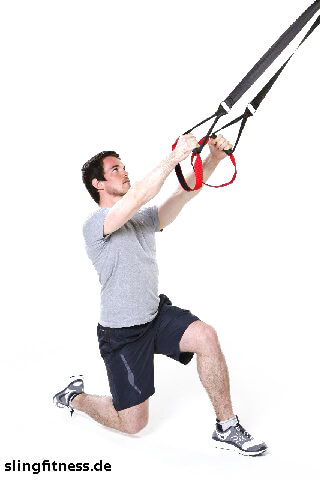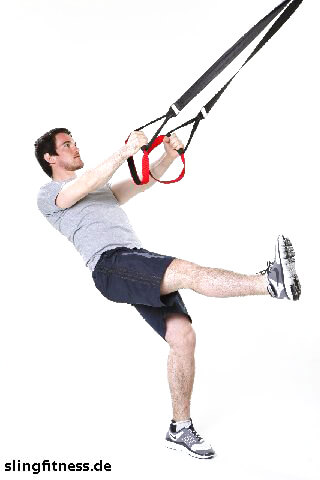Primary: Legs, Glutes (quadrizeps, ischiocrurale M., gluteen)
Secondary: Back, Arms (latissimus, erector spinae, bizeps brachii, palmarflexoren)
The one-legged Squat requires a good stability and balance of the supporting leg. By lowering the buttocks backward the knee joint gets relieved and the muscles get specifically trained. By executing a kick during the straightening phase, more muscle chains in the ischiocrural area get controlled. A good sense of balance is obligatory.
The following figures illustrate the exercise Squat One-Legged with Kick:
 |
 |
| Suspension Training Leg Exercises | |
|
Starting Position The arms are stretched and the back is upright and lightly leaned forward. The weight is on the heel of the supporting leg. The rear leg is lowered down backwards. The knee of the swinging leg points in direction of the bottom and is strongly flexed. |
Final Position The arms are stretched and the upper body is leaned backwards. The weight is on the heel of the supporting leg. The back leg is clearly stretched forward and the toes are tightened. |
|
Movement 1 The body is moved back downwards. The swinging leg is flexed and lowered back downwards. |
Movement 2 The body gets raised up again by the power of the supporting leg. The supporting leg gets both stretched in the hip and in the knee joint. Parallel the swinging leg is moved up to the horizontal line and the toes are tightened. |
|
Hint: The weight has to be completely on the heel of the supporting leg. Do not move the knee of the supporting leg over the tiptoes. The higher you kick your swinging leg, the stronger is the intensity for the posterior thighs. The range of motion should be extended piece by piece. |
|
